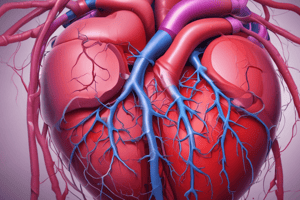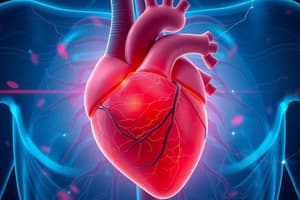Podcast
Questions and Answers
Which of the following symptoms is NOT commonly associated with left heart failure?
Which of the following symptoms is NOT commonly associated with left heart failure?
- Constipation (correct)
- Cough
- Wheezing
- Tachycardia
What is a characteristic feature of left heart failure related to breathing?
What is a characteristic feature of left heart failure related to breathing?
- Tachypnea (correct)
- Apnea
- Bradycardia
- Hypoventilation
Which action is most effective in reducing cardiac work?
Which action is most effective in reducing cardiac work?
- Introducing stress-reducing techniques
- Restricting patient activities (correct)
- Prescribing dietary supplements
- Increasing physical exercise
Which clinical finding might indicate fluid accumulation in the lungs due to left heart failure?
Which clinical finding might indicate fluid accumulation in the lungs due to left heart failure?
Which of the following would be considered a method to correct underlying causes of impaired cardiac performance?
Which of the following would be considered a method to correct underlying causes of impaired cardiac performance?
What is a potential intervention that might reduce cardiac work through mechanical means?
What is a potential intervention that might reduce cardiac work through mechanical means?
In left heart failure, which symptom may signify the body's compensatory mechanism?
In left heart failure, which symptom may signify the body's compensatory mechanism?
Which of the following treatment methods is least likely to help with fever management in cardiac patients?
Which of the following treatment methods is least likely to help with fever management in cardiac patients?
What is a common respiratory symptom associated with left heart failure that affects lung function?
What is a common respiratory symptom associated with left heart failure that affects lung function?
What is a common approach to improve cardiac performance through patient lifestyle modifications?
What is a common approach to improve cardiac performance through patient lifestyle modifications?
What is one symptom associated with peripheral cyanosis?
What is one symptom associated with peripheral cyanosis?
Which of the following is a recommended positioning for treatment?
Which of the following is a recommended positioning for treatment?
Reducing cardiac work is a goal in the treatment of which condition?
Reducing cardiac work is a goal in the treatment of which condition?
What indicates a problem with nutrient absorption as suggested by the symptoms?
What indicates a problem with nutrient absorption as suggested by the symptoms?
Which treatment aims to improve heart muscle function?
Which treatment aims to improve heart muscle function?
Which symptom might indicate inadequate blood circulation?
Which symptom might indicate inadequate blood circulation?
What is a significant risk associated with a small volume pulse?
What is a significant risk associated with a small volume pulse?
Which of the following treatments is NOT typically prioritized in managing cyanosis?
Which of the following treatments is NOT typically prioritized in managing cyanosis?
What activities are considered a violation of the Copyright Act according to the content?
What activities are considered a violation of the Copyright Act according to the content?
What forms of reproduction are listed as equal violations under the Copyright Act?
What forms of reproduction are listed as equal violations under the Copyright Act?
Who can be held accountable for violations of the Copyright Act regarding these notes?
Who can be held accountable for violations of the Copyright Act regarding these notes?
Which of the following platforms is mentioned as a potential medium for violating copyright?
Which of the following platforms is mentioned as a potential medium for violating copyright?
What is the consequence mentioned for violating the Copyright Act?
What is the consequence mentioned for violating the Copyright Act?
Which of the following is NOT included as a mechanical means of reproduction?
Which of the following is NOT included as a mechanical means of reproduction?
What should be avoided to prevent copyright violations regarding notes?
What should be avoided to prevent copyright violations regarding notes?
Reproduction of notes by which of the following methods is allowed?
Reproduction of notes by which of the following methods is allowed?
What is the primary benefit of propping a patient up to 30 degrees?
What is the primary benefit of propping a patient up to 30 degrees?
Which class of medication helps to reduce the renin-angiotensin-aldosterone system?
Which class of medication helps to reduce the renin-angiotensin-aldosterone system?
What is the role of β-blockers in managing heart function?
What is the role of β-blockers in managing heart function?
How do ACE inhibitors contribute to reducing cardiac workload?
How do ACE inhibitors contribute to reducing cardiac workload?
What effect does pooling of edema fluid have when a patient is not propped up?
What effect does pooling of edema fluid have when a patient is not propped up?
What is a consequence of using β-blockers in heart failure management?
What is a consequence of using β-blockers in heart failure management?
In what way does propping a patient up to 30 degrees affect their breathing?
In what way does propping a patient up to 30 degrees affect their breathing?
Which of the following is NOT a direct action of ACE inhibitors?
Which of the following is NOT a direct action of ACE inhibitors?
What is the primary definition of Congestive Cardiac Failure?
What is the primary definition of Congestive Cardiac Failure?
Which of the following is NOT a common cause of Congestive Cardiac Failure in infants?
Which of the following is NOT a common cause of Congestive Cardiac Failure in infants?
What symptom is associated with right heart failure?
What symptom is associated with right heart failure?
Which condition is identified as a cause of congestive heart failure specifically in children?
Which condition is identified as a cause of congestive heart failure specifically in children?
Which of the following features is least likely to be associated with right heart failure?
Which of the following features is least likely to be associated with right heart failure?
What mechanical method of reproduction is considered a violation of copyright according to the content?
What mechanical method of reproduction is considered a violation of copyright according to the content?
In adults, which of the following is not a common cause of congestive heart failure?
In adults, which of the following is not a common cause of congestive heart failure?
What condition is indicated by raised JVP in right heart failure?
What condition is indicated by raised JVP in right heart failure?
Flashcards
Pedal Edema
Pedal Edema
A buildup of fluid in the legs, causing swelling, often seen in people with heart failure.
Left Heart Failure
Left Heart Failure
A sign of left heart failure where the heart cannot effectively pump blood throughout the body, leading to fluid buildup in the lungs.
Wheezing
Wheezing
A forceful expulsion of air from the lungs, often accompanied by a whistling sound, a common symptom of left heart failure.
Tachycardia
Tachycardia
Signup and view all the flashcards
Tachypnea
Tachypnea
Signup and view all the flashcards
Copyright Infringement
Copyright Infringement
Signup and view all the flashcards
Copyright
Copyright
Signup and view all the flashcards
Reproduction (of copyrighted material)
Reproduction (of copyrighted material)
Signup and view all the flashcards
Means Of Reproduction
Means Of Reproduction
Signup and view all the flashcards
Copyright Act
Copyright Act
Signup and view all the flashcards
Punishable & Fined
Punishable & Fined
Signup and view all the flashcards
Directly Involved
Directly Involved
Signup and view all the flashcards
Indirectly Involved
Indirectly Involved
Signup and view all the flashcards
Congestive Heart Failure
Congestive Heart Failure
Signup and view all the flashcards
Myocarditis
Myocarditis
Signup and view all the flashcards
Kawasaki Disease
Kawasaki Disease
Signup and view all the flashcards
Persistent Pulmonary Hypertension of the Newborn (PPHN)
Persistent Pulmonary Hypertension of the Newborn (PPHN)
Signup and view all the flashcards
Periorbital Swelling
Periorbital Swelling
Signup and view all the flashcards
Facial Puffiness
Facial Puffiness
Signup and view all the flashcards
Raised JVP
Raised JVP
Signup and view all the flashcards
Tender Hepatomegaly
Tender Hepatomegaly
Signup and view all the flashcards
Peripheral Cyanosis
Peripheral Cyanosis
Signup and view all the flashcards
Not Gaining Weight
Not Gaining Weight
Signup and view all the flashcards
Small Volume Pulse
Small Volume Pulse
Signup and view all the flashcards
Airway (30° propped up)
Airway (30° propped up)
Signup and view all the flashcards
Breathing
Breathing
Signup and view all the flashcards
Circulation
Circulation
Signup and view all the flashcards
Reducing Cardiac Work
Reducing Cardiac Work
Signup and view all the flashcards
Increasing Myocardial Contractility
Increasing Myocardial Contractility
Signup and view all the flashcards
Restricting patient activities
Restricting patient activities
Signup and view all the flashcards
Sedatives
Sedatives
Signup and view all the flashcards
Treat fever/anemia/obesity
Treat fever/anemia/obesity
Signup and view all the flashcards
Mechanical ventilation
Mechanical ventilation
Signup and view all the flashcards
Propped up to 30 degrees
Propped up to 30 degrees
Signup and view all the flashcards
ACE Inhibitors in Heart Failure
ACE Inhibitors in Heart Failure
Signup and view all the flashcards
Beta-blockers in Heart Failure
Beta-blockers in Heart Failure
Signup and view all the flashcards
Reducing Vasoconstriction and Fluid Retention
Reducing Vasoconstriction and Fluid Retention
Signup and view all the flashcards
Study Notes
Cardiovascular System (Part 12)
- Congestive Cardiac Failure: Inability of the heart to maintain adequate output, either at rest or during exertion.
Causes of Congestive Cardiac Failure (Infant)
- Congenital Heart Disease
- Myocarditis
- Kawasaki Disease (with coronary occlusion)
- Persistent Pulmonary Hypertension of the Newborn (PPHN)
- Miscellaneous: Anemia, Hypoglycemia
- Infections/Hypocalcemia
Causes of Congestive Cardiac Failure (Children)
- Rheumatic Fever (beyond 5 years of age)
- Rheumatic Heart Disease
- Systemic Hypertension
- Myocarditis
Features of Right Heart Failure
- Periorbital swelling
- Facial puffiness
- Elevated Jugular Venous Pressure (JVP)
- Tender Hepatomegaly
- Ascites
- Effusion
- Scrotal Edema
- Bilateral pitting pedal edema
Features of Left Heart Failure
- Cough
- Wheezing
Cardiac Enlargement Features
- Peripheral cyanosis
- Not gaining weight
- Small volume pulse
Treatment for Congestive Cardiac Failure
- Airway Management (30° propped up)
- Breathing Support
- Circulatory Support (reducing cardiac work, increasing myocardial contractility, improving cardiac performance, and correcting underlying cause)
- Restricting patient activities
- Sedatives
- Treating fever, anemia, and obesity
- Mechanical Ventilation; and, Prop up to 30 degrees. This positioning helps to reduce edema pooling in the lungs.
- ACE inhibitors (e.g., Captopril/Enalapril): Reduce the renin-angiotensin-aldosterone system, reducing vasoconstriction and salt/water retention.
- Beta-blockers (e.g., Metoprolol/carvedilol): Reduce tachycardia.
Medication Dosages (for Increasing Myocardial Contractility)
- Digoxin: Dose(s) vary based on the patient's age (premature neonates, 1 month-1 year, etc.).
- Diuretics (e.g., Furosemide, Spironolactone): dosages also based on age and other factors (such as dosage per kg/body weight).
Studying That Suits You
Use AI to generate personalized quizzes and flashcards to suit your learning preferences.




